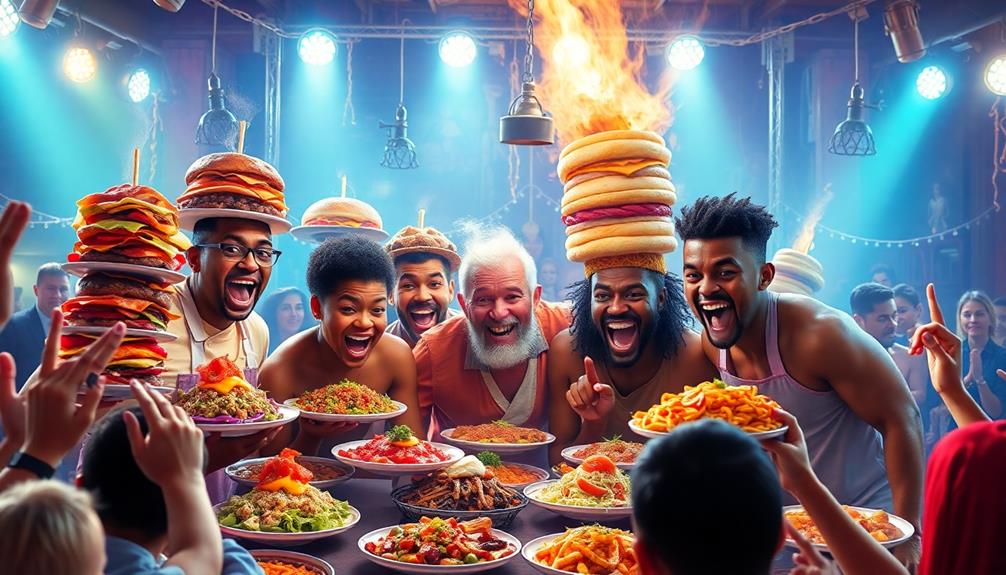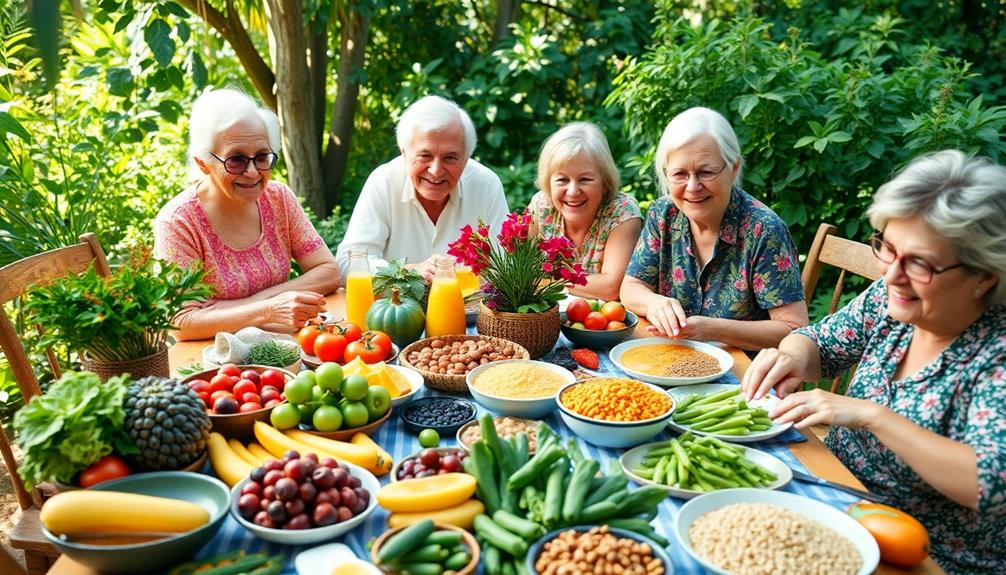The psychology behind food challenges and eating competitions is fascinating and complex. You might find that many participants seek recognition and a boost in self-esteem through impressive feats of consumption. These challenges often serve as social bonding experiences, where friends gather to support each other. However, the thrill comes with risks, such as health complications and potential eating disorders. Many competitors also engage in extreme training to prepare for events. Understanding these psychological motivations sheds light on the interplay between food, identity, and societal influences, setting the stage for deeper insights into this unique cultural phenomenon.
Key Takeaways
- Competitive eating blends skill and determination, with roots dating back to 1916, evolving into a recognized sport featuring various cuisines.
- Participants often seek recognition and validation, with social dynamics influencing their motivation, particularly among males.
- Health risks include permanent stomach stretching, gastroparesis, and increased likelihood of disordered eating patterns.
- Rapid food consumption raises choking hazards, necessitating safety measures and medical readiness during competitions.
- Ethical concerns arise from food waste and the juxtaposition of excess in competitions against widespread food insecurity.
The Nature of Competitive Eating
Competitive eating, at its core, blends skill, strategy, and sheer determination. It's a fascinating arena where participants push their limits, often in eating contests that date back to 1916 with Nathan's Famous hot dog competition. You might be surprised to learn that the first winner consumed a mere 13 hot dogs, while today's champions can devour over 70 in just 10 minutes. This evolution highlights how competitive eating has transformed into a spectacle, drawing more enthusiasts enthusiastic to test their mettle.
Some competitors even incorporate unique dishes from various cuisines, such as Red-Braised Pork Belly, adding a rich flavor and texture to their challenges.
As you immerse yourself in this world, you'll notice how dietary habits of competitive eaters differ markedly from mainstream eating patterns. These athletes train rigorously, often embracing extreme strategies to maximize their intake. They rely on community support and media exposure, which glamorizes their feats and fosters a sense of belonging. Shows like "Man v. Food" have popularized these eating challenges, making them more accessible to the public.
However, competitive eating also raises ethical concerns. Critics argue these contests symbolize broader societal issues, especially when millions face hunger while excessive food is consumed and wasted during these events. Balancing the thrill of competition with awareness of these issues is essential.
Psychological Motivations Behind Participation
Many participants in food challenges are driven by a complex mix of psychological motivations that go beyond mere hunger. The thrill of competition and the desire for recognition often push competitive eaters to consume staggering amounts of food. This culture glamorizes excessive consumption, creating a pressure to eat that can overshadow personal limits.
Curiously, some may also be influenced by cultural traditions surrounding food, such as the communal experience of sharing dishes like Mushroom Masala, which emphasizes how food can bring people together.
Here are some key motivations behind participation in food challenges:
- Recognition and Validation: Many seek admiration from peers and spectators, feeling a rush from extreme feats.
- Social Dynamics: Male participants often enjoy a boost in self-perception, while females may struggle with self-consciousness in competitive settings.
- Entertainment: For some, food challenges serve as a fun way to bond with friends and explore cultural fascination with extreme eating behaviors.
- Impressing Others: The desire to wow spectators can lead competitive eaters to consume four times more food than non-participants.
Understanding these psychological motivations reveals why people are drawn to food challenges and how societal influences shape their experiences.
Ultimately, it's a blend of thrill, social dynamics, and personal ambition that fuels their participation in these unique competitions.
Health Risks and Consequences
While the thrill of food challenges can be enticing, it's important to recognize the serious health risks that come with them. Competitive eating isn't just about fun; it can lead to severe consequences.
Training for these challenges often results in permanent stomach stretching, affecting how your body digests food. This can trigger long-term effects like chronic nausea and vomiting, with some individuals suffering from gastroparesis that might require medical intervention.
Additionally, consuming excessive quantities of food can overshadow the enjoyment of nutritious dishes like Ethiopian salads or roasted barley, which bring a wealth of health benefits.
Moreover, the pressure to perform can drive participants to adopt disordered eating habits, mirroring socially sanctioned bulimia. Approximately 30 million Americans struggle with eating disorders, and competitive eaters are at an increased risk.
The use of performance-enhancing drugs, such as insulin to boost appetite, adds another layer of health concerns, further complicating their relationship with food.
Ultimately, while you might chase the excitement of food challenges, the potential health risks, including the psychological impacts of disordered eating, can have lasting effects.
It's essential to weigh these consequences against the fleeting thrill of competition before diving headfirst into the world of competitive eating.
The Role of Choking Hazards
When you participate in food challenges, it's essential to be aware of the choking hazards that come with rapid consumption.
Foods, especially those that are dense or require extensive chewing, like scalloped potatoes, can be particularly risky in a competitive setting.
Understanding these risks can help you take safety measures seriously, making the experience safer for everyone involved.
Implementing proper guidelines and training can greatly reduce the likelihood of choking incidents during these competitions.
Increased Risk Awareness
In the high-pressure environment of eating competitions, the thrill of rapid consumption often overshadows a vital concern: the risk of choking. Choking is one of the most notable hazards participants face, posing life-threatening dangers. Statistics highlight that numerous fatalities have occurred during these events, emphasizing that the risks faced by anyone—especially amateur eaters—are substantial.
Participants may be indulging in various foods, including popular options like Chilaquiles and Quesadillas, which can present unique challenges when consumed quickly. The exhilarating atmosphere and time constraints can lead to reckless eating behaviors, which increase choking hazards.
To foster a safer environment, awareness of these risks is essential. Here are some key considerations:
- Inexperience: Amateur participants may lack the necessary skills to handle large quantities of food safely.
- Pressure to Perform: The urge to eat quickly can cloud judgment, making participants ignore their limits.
- Food Types: Certain foods, like large meat pieces or dry items, are more likely to cause choking incidents.
- Event Organization: Proper planning and training can considerably reduce choking risks during competitions.
Safety Measures Implementation
The risks of choking during competitive eating events can't be overlooked, making the implementation of safety measures a top priority. With statistics showing that choking is a leading cause of fatalities, especially among inexperienced participants, awareness is essential. The pressure to consume food rapidly, combined with limited time constraints, heightens the risk of choking incidents.
For instance, popular dishes like Loaded Baked Potato can pose unique challenges due to their size and texture, making it necessary to establish effective safety protocols.
To combat these dangers, organizers should prioritize having medical personnel on-site during contests. This guarantees immediate assistance in case of choking emergencies. Additionally, providing training on proper eating techniques can greatly reduce risks.
Educating participants about the perils of rapid food consumption is important; understanding the signs of choking and how to respond can save lives.
Incorporating thorough safety measures not only protects participants but also fosters a culture of responsibility within the competitive eating community. By prioritizing training and emergency preparedness, you can help mitigate the risks associated with this thrilling yet dangerous activity.
Long-term Effects on Health
Competitive eaters often face serious long-term health risks that can drastically affect their quality of life. Engaging in this extreme sport can lead to complications such as obesity and digestive disorders, which may require surgical interventions.
Training to expand stomach capacity can cause permanent stretching, hampering gastric emptying and overall digestive health. Additionally, the high consumption of certain foods may lead to nutritional imbalances, as many competitive eaters may prioritize volume over the quality of ingredients, potentially missing out on essential nutrients.
Dishes like Caldeirada highlight the importance of balanced meals rich in seafood and vegetables, which can be overlooked in competitive eating.
Here are some specific health risks you might encounter:
- Obesity: Compulsive eating can lead to an increased body mass, exacerbating health issues.
- Gastroparesis: This condition slows down digestion, causing nausea and vomiting.
- Surgical interventions: Some may require procedures like gastrectomy due to severe complications.
- Fatalities: Over 20 documented deaths highlight the extreme risks, including choking.
Since competitive eating is a relatively new phenomenon, the long-term health outcomes remain largely unknown.
You might find yourself part of the first generation of competitive eaters facing ongoing digestive issues. As the sport evolves, understanding the balance between competition and health is essential for anyone considering participation.
Eating Disorders and Competitive Eating
Eating disorders and competitive eating share a troubling connection that often goes unrecognized. Many participants in competitive eating develop disordered eating patterns that resemble those seen in individuals with eating disorders. With about 30 million Americans suffering from eating disorders, the overlap between competitive eating and unhealthy eating behaviors is significant.
The normalization of excessive food consumption in competitive eating can create a disconnect from the fundamental joys of food, such as enjoying seasonal dishes like Nettle and Potato Soup, further complicating participants' relationships with what they eat.
In the high-pressure environment of competitive eating, the normalization of excessive food consumption can exacerbate tendencies toward disordered eating. You might notice that some competitive eaters view their contests as monetized eating disorders, reflecting a complex relationship with food.
The extreme training practices required can lead to severe health consequences, including nausea, vomiting, and gastroparesis—symptoms that are prevalent in those with eating disorders.
It's essential to recognize that the drive to perform can push individuals toward unhealthy eating habits, blurring the line between sport and disorder. By understanding this connection, you can appreciate the nuances of competitive eating, as it often masks deeper issues related to food and body image.
Acknowledging these realities can help foster a healthier dialogue around both competitive eating and eating disorders.
Performance Enhancement Techniques
When you're pushing your limits in competitive eating, you might consider using medications to boost your performance or training techniques to manage discomfort.
Exploring diverse culinary experiences, like Asian cuisine, can also help you understand how different foods may affect your stamina and energy levels.
However, these methods come with serious risks that can affect your health long-term.
It's crucial to weigh the potential benefits against the dangers before you decide to go down this path.
Medications for Performance Boost
In the world of food challenges, some participants turn to medications for a performance boost, seeking an edge in their contests. Competitive eaters often experiment with various substances to enhance their abilities, but these performance-enhancing drugs can pose significant health implications.
Traditional dishes such as Muamba De Galinha showcase the rich flavors and communal aspects of food, which can sometimes be overshadowed by competitive eating.
Consider the following points:
- Insulin: Some use it to lower blood sugar levels, which may enhance appetite.
- Nausea suppressants: These allow for larger quantities of food intake without discomfort.
- Ethical concerns: The use of medications raises questions about fairness in competitions.
- Health risks: Medications can mask distress symptoms, increasing injury risk.
While these drugs might provide a temporary advantage, medical professionals warn that their long-term effects remain largely unknown.
The potential for severe injuries or adverse outcomes from these performance-enhancing substances is a critical concern.
The competitive eating community must consider the need for oversight and regulation to guarantee the safety and integrity of the sport.
As you navigate this environment, keep in mind the ethical and health considerations surrounding the use of medications in food challenges. Your well-being should always come first.
Training Techniques and Risks
Competitive eating training often combines physical techniques with psychological strategies to maximize performance. As a competitive eater, you might engage in stomach stretching techniques, gradually increasing your capacity to hold over 4 liters of food. While this can enhance your performance, it also poses significant health risks, including permanent changes to your digestive health.
Training typically involves consuming large volumes of water rapidly to stretch your stomach, which can push your organs out of their normal positions. Some eaters even resort to performance-enhancing drugs, like insulin, to lower blood sugar and boost appetite. This raises serious health concerns, especially regarding long-term damage to your digestive system.
Mental preparation is equally important; you need to learn to ignore your nausea reflex to consume quantities far beyond typical limits. However, extreme training regimens can involve hazardous practices, increasing the likelihood of serious health risks such as choking and gastroparesis.
Balancing the drive for competitive success with the potential dangers of these training techniques is essential to guarantee your well-being while pursuing your passion for competitive eating.
Ethical Issues and Food Waste
Food challenges raise pressing ethical issues, particularly regarding the staggering amount of waste generated and the stark contrast to those facing hunger. With over 40 million Americans dealing with food insecurity, watching someone consume an extraordinary amount of food can feel disheartening. Critics argue that glorifying competitive eating desensitizes society to both food waste and the ethical implications of consuming excessively while many lack basic nutrition.
Consider these points:
- One participant's consumption may satisfy the hunger needs of several individuals.
- Reports of over 20 fatalities since 2010 highlight serious health risks tied to eating contests.
- The potential normalization of unhealthy eating habits can perpetuate cycles of waste and poor dietary choices.
- The use of performance-enhancing drugs raises questions about fairness and the need for ethical regulations.
These concerns prompt a reevaluation of our relationship with food, particularly in a world where waste is rampant, and hunger is prevalent. Competitive eating not only raises ethical issues but also challenges us to think critically about our consumption habits, ensuring we promote responsible practices that prioritize both health and sustainability.
Maintaining a Healthy Relationship With Food
As society grapples with the ethical implications of food challenges and the troubling waste they generate, it's important to focus on cultivating a healthy relationship with food. Mindful eating can help you tune into your hunger cues and fullness signals, promoting a balanced approach that reduces the risk of overeating. By maintaining regular meal patterns, you can avoid the pitfalls of binge eating that come from skipping meals.
Here's a quick overview of helpful eating styles:
| Eating Style | Benefits |
|---|---|
| Mindful Eating | Enhances awareness of hunger and fullness |
| Balanced Meal Patterns | Supports steady energy levels |
| Inclusive Eating | Fosters a diverse and enjoyable diet |
Creating a relaxed eating environment can also enhance your comfort with food, reducing anxiety and preventing rigid eating habits. Engaging in healthy eating practices not only nurtures a positive relationship with food but can also improve your mental well-being, helping to mitigate issues related to eating disorders. By prioritizing these practices, you can foster a healthy relationship that encourages a joyful, sustainable approach to eating.
Frequently Asked Questions
What Is the Science Behind Competitive Eating?
Competitive eating involves training your stomach to stretch beyond its normal capacity, allowing you to consume large amounts of food quickly. Your body adapts through practice, impacting your metabolic responses and overall eating behaviors.
Why Don't Competitive Eaters Get Fat?
Like a well-tuned engine, you'll notice competitive eaters often balance strategic dieting with intense training. Their unique metabolisms adapt over time, allowing them to consume massive amounts without significant weight gain.
What Happens to Your Body When You Do a Food Challenge?
When you do a food challenge, your stomach stretches considerably, causing discomfort. You might experience nausea, vomiting, and potential choking risks. Over time, these extreme eating habits can lead to serious health issues.
Do Competitive Eaters Throw up After the Contest?
Imagine a balloon stretched to its limit, ready to burst. After a contest, many competitive eaters find themselves in similar discomfort, often leading them to vomit as a method of relief from the overwhelming fullness.
Conclusion
In the wild world of competitive eating, you've got to ask yourself: is the thrill of devouring mountains of food worth the perilous plunge into health risks? Sure, the adrenaline rush is intoxicating, but it can lead to a stomach-churning spiral of chaos and consequences. Let's not kid ourselves; you're not just battling plates—you're wrestling with your relationship with food. Remember, life's too short to risk your health for a fleeting moment of glory. Choose balance over binge!









